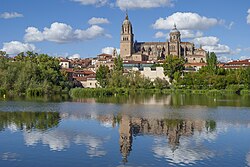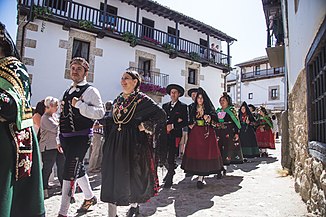| Salamanca province | |
 | |
Location .svg/250px-Salamanca_in_Spain_(plus_Canarias).svg.png) | |
Coat of arms and flag | |
| State | Spain |
|---|---|
| Region | Castile and León |
| Capital | Salamanca |
| Surface | 12,349 km² |
| Inhabitants | 333.603 (2017) |
| Tourism site | |
| Institutional website | |
Salamanca is a province of the autonomous community of Castile and León, in Central Spain.
To know
Geographical notes
The territory of the province extends in the southwestern corner of the plateau (meseta) central with flat landscapes interrupted by slight undulations. To the south extend the sierras of Gata, France-Quilamas and Béjar, continuation to the west of the "Central System", a chain of mountains that runs through the center of meseta, dividing the Old from New Castile.
The western region, known as "Arribes del Duero" is crossed by the river Duero which in this section has carved out deep gorges of scenic interest.
Territories and tourist destinations
Urban centers
- 1 Alba de Tormes - The place where on October 4, 1582, Santa Teresa died. His sepulcher is placed under the main altar of the church of the convent of Discalced Carmelite nuns and is the object of devotion by the faithful.
- 2 Béjar - Town on the sierra of the same name at 950 m. of altitude, Béjar it was in the 15th century a fief of the Dukes of Plasencia and from the time it retains a noble palace and a country estate with an Italian-style Renaissance garden (Parque de El Bosque). The town is the terminus of tourist trains which operate only in summer.
- 3 Candelarium - Sierra village with typical stone houses, Candelarium is a summer resort, also famous for religious festivals, local traditions and gastronomic specialties including embutido, a very spicy salami.
- 4 Ciudad Rodrigo - Located near the border line with Portugal, Ciudad Rodrigo is a pretty town of 10,000 inhabitants on the banks of the Águeda, a left tributary of the Duero and boasts interesting vestiges of its rich past, including granite sculptures, made by the Vettoni, a people of Celtic origin
- 5 Guijuelo - Town in an area of high mountain pastures, famous throughout the Spain for the production of hams and sausages (embutidos).
- 6 La Alberca - Village of the Sierra de Francia, La Alberca it is located at an altitude of over 1,000 m. and boasts traditional stone and wood houses. It is the best starting point for excursions to the surrounding valleys and every year in March there is a conference for trekking enthusiasts (Tresvalles).
- 7 Ledesma - Bathed by the Tormes River, Ledesma is a town of pre-Roman origin with an interesting historic center and remains of 13th century walls and fortresses.
- 8 Miranda del Castañar - Village in the Sierra de France, Miranda del Castañar it was founded in the 13th century by the Hospitaller Knights then evolved into the order of Malta and remains a castle in a good state of conservation.
- 9 Salamanca - Very lively university town, Salamanca it is famous for its Renaissance-style monuments which make it one of the most pleasant cities in the Castile.
Other destinations
- 1 Las Batuecas Natural Park - Sierra of France (Parque natural de Las Batuecas-Sierra de Francia) - The wooded mountains that mark the border with the province of Cáceres they are ideal for various excursions starting from the villages of Béjar or Candelarium. Las Batuecas is the valley at whose outlet it is located La Alberca, one of the prettiest villages in the Sierra. One of the most popular excursions is to go up the difficult hairpin bends of the SA-201 road to "Las Mestas", a village of few houses dedicated to beekeeping located at the confluence of the Batuecas and Ladrillar rivers.
- 2 Arribes del Duero Natural Park (Parque natural de Arribes del Duero) - Park that embraces the stretch of the Duero that marks the border between Spain is Portugal and characterized by spectacular gorges. The main attractions of the park are the Pozo de los Humos, waterfall on the course of the Uces river and the Saucelles dam.

Folklore a Candelarium
Pozo de los Humos
How to get
On the train
Salamanca is located at the intersection of two railways, one coming from Madrid and traveled by Alvia high-speed trains and the other still not fully electrified by Fuentes de Oñoro (border with the Portugal) to Medina del Campo, traveled by the international night trains "Surexpreso" in service from Lisbon to Hendaye (border frank—Spanish).
How to get around
What see
What to do
At the table
Safety
Other projects
 Wikipedia contains an entry concerning Salamanca province
Wikipedia contains an entry concerning Salamanca province Commons contains images or other files on Salamanca province
Commons contains images or other files on Salamanca province




.jpg/290px-Vista_general_de_Ledesma_(Salamanca,_Castilla_y_León,_España).jpg)
